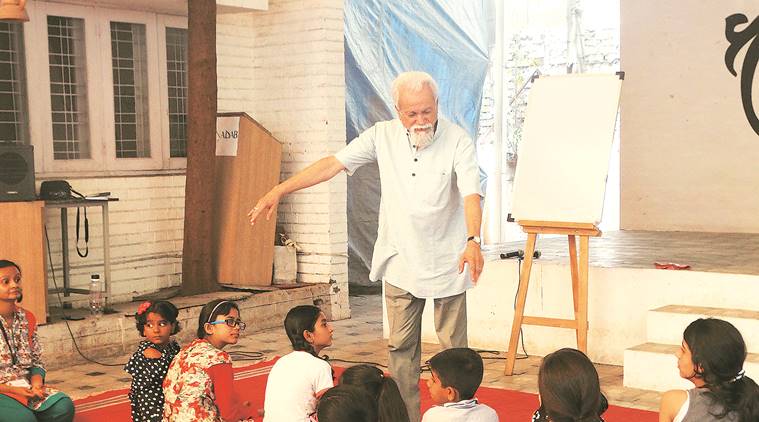Not a Child’s Play
A children’s play by Randhir Khare takes one through the enchanting world of children’s dreams
Written by Alfiya Khan | Updated: July 1, 2018 12:00:11 am

Randhir Khare during the workshop
Celebrated child psychologist Bruno Bettelheim, in his book The Uses of Enchantment, makes a strong case for fairytales and their irreplaceable value in educating, supporting and liberating the emotions of children. It is based on the same premise that writer, director, and educator Randhir Khare takes with fairytales as the theme for his latest production, The Dream that Changed the World. A play of, by and for children, it was staged on Saturday.
Through the fairytale format, Khare hopes to help children find solutions to their inner fears. For his play, he chose dreams to be the tool for fantasy. “The need to write the play stemmed from my own childhood experiences of fear, particularly fear of bullying, of an insensitive school system and of course of parental expectations. Later when I became a teacher in a Mumbai school at 22, I discovered that numerous children were going through the same experiences that I had experienced. Now, after 40 years of teaching, my deepest fears have been confirmed. Children are still challenged by fear, except of course that the fear is much more complex. In one on one sessions I had the opportunity to hear how these fears have manifested into nightmares,” says Khare.
A 12-year-old girl who he had hoped would be co-writer of the play told him about her fears and also her unique ability to transform nightmares into beautiful dreams. And so were sown the seeds of the story of the play.
Developed over a series of workshops conducted with young actors, the play produced by Gyaan Adab’s Children’s Theatre, revolves around dreams. “But have you heard of four kids sharing the same dream? Imagine if they find it so exciting, challenging, terrifying, hopeful and beautiful that they cease to be afraid and instead keep finding solutions. In the process, they offer other children a new way of dealing with fear,” says Khare.
The play is about the importance of dreaming, hoping, striving – for a better world and is meant to be an inspirational journey which will offer kids humane, creative and liberating experiences that will help them find their own special solutions.
Since the primary audience of the play is children, the use of visuals and sound was equally important which is why the use of chants and wordplay as well as choreographed contemporary dance sequences was woven into the storytelling. All the performers of the play were between the ages of 7 and 13, who came up with their own improvisations, making characters more believable.
“I have this character, Shade, who is the CEO of nightmares and his assistants are Shadow and Scum. This boy who plays Scum was told that his character is slimy. So when he entered, he came in and slipped, being slimy. It is fantastic, how these kids use imagination. They are better than experienced adult actors who come with pre-conceived notions,” says Khare.
Since the primary audience for the play is kids, who have short attention spans, writing theatre for them requires a different approach. “If you put in too much detail or clutter, you have lost them. Children don’t want ornate things, they want the essence. You see children are most honest critics. That’s why you have to keep them engaged and for that, I chose the dream format. The action is constantly mutating here, there is constant movement but the central concerns remain the same,” he says.
Khare now hopes to take the play to several schools because he believes it will help start a discussion. “I hope after watching this play, children realize they are very empowered,” says Khare.
For all the latest Lifestyle News, download Indian Express App






















No hay comentarios:
Publicar un comentario